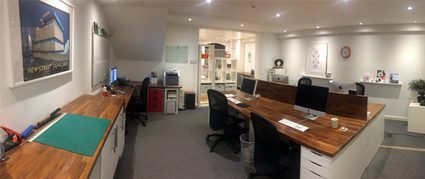How to go remote

Firstly I should clear-up a language thing – we aren't actually, strictly a ‘remote’ team. We all work from our respective homes in and around Birmingham, rather than on a beach in Goa, up a Swiss mountain, or from a Portland coffee shop.
‘Remote’ just seems more immediately understandable than calling it telecommuting which sounds super '80s but is technically correct, or saying we're a ‘distributed team’. Again that’s an accurate description but the phrase isn’t that widely understood – at the moment at least.
So, for the time-being, ‘remote’ is decent shorthand.

Having explained the reasons why we were considering ditching the office, how did we make the decision once-and-for-all to do this thing, and then turn a business that’d been based in the same building for nigh-on 13 years into a more lightweight and flexible entity?
Here's how we approached the change – minus the overly-obvious stuff like "we packed-up the office", "we made sure everyone had a chair" etc.
1: Make it a team decision
This was one of the main considerations for us. Work’s a big part of people’s lives, and every Supercooler has an input not only into their specific role, but the work we do as a company, and how we do it.
No longer having a central office would be a big change for everyone, so we discussed the possibility openly and at length – what we thought would work, what’d need to change, the things that worried us …
And right from the start we agreed that if we weren’t all happy with the change, we wouldn’t do it. Simple.
2. Research and plan
We researched as much as humanly possible; which primarily involved reading about the various types of central-office-less working that other companies had already tried-out; the benefits, the potential pitfalls, and the practicalities. (Links to some of these are listed below.)
An added complication in our case was that, alongside potentially ditching the office, we were hiring a new team member. Ruh-roh!
So, as well as trying to find a new person with the right skills, who was the right fit for the team in general, we were looking for someone who was okay – at least in principle – with working from home. We were open about our plans during the recruitment process and, happily, found Naveed who fitted the bill on every count. WIN!
Back to planning – all each of us really needs to do our job is a decent computer and a decent internet connection. But added to this are the nuts-and-bolts that make communicating with each other quick and easy. Most online tools that're useful for remote/distributed teams we’d been using for ages – Slack, Trello, Hangouts etc. – so were already ingrained in day-to-day processes, but other stuff was new and needed setting up.
The most useful thing we put in place fairly early-on was a VOIP phone system. Even if we didn’t end up ditching the office, it made sense to have VOIP rather than a traditional phone line – the same phone number, with a bunch of added functionality, for a lower cost? No brainer.
3: Beta test
We applied some of the same principles we use to run digital projects to going remote, specifically that meant getting the bare bones of what we needed set up quickly – a minimum viable product if you will – and giving it a go.
We ended up doing several week-or-so-long trial runs.
Perhaps it was that we'd all discussed it openly and thoroughly. Perhaps it was the prior planning and preparation. Perhaps it was because we were using most of the tools already, so the change in how we work was actually fairly minimal. Whatever the reasons, the trial runs went brilliantly and – crucially (see point 1) – everyone was up for making it a permanent change.
Farewell cumbersome desktop computers; laptops all round!
4: Be clever with communication
Rather than one big meeting a week, we now all get together in a Google Hangout first thing every morning.
It’s a good chance to catch-up with each other and go over what work needs doing that day – as well as reminding ourselves that we work in a team. This was one of the things all our research suggested was a good idea, and it really is important. I’d go so far as to say it's vital.
During the trial runs Josh found, and got us into using Appear In (since rebranded as Whereby); a mega-simple screen sharing service which we’ve since adopted to talk-through designs. It’s great – so much easier and more efficient than doing the same thing face-to-face, all gathered around a single screen.
And it wasn’t just the screen-sharing; we’re now working together more efficiently in general. I guess having to be more structured about when and how we talk to each other has forced us to make better use of that time. Nice side effect.
Our communication isn’t all about work though.
We've been sure to keep-up the little niceties which are important to human interaction but could easily get cut-out when people aren't actually in the same room.
Tiny things like saying “Hi” and “Bye” every day, and nonsense chat about this and that over Slack – with added emojis/animated gifs, obvs – are a a bit of human interaction and help punctuate the day. It seems to do a similar job to tea breaks IRL.
We also still get together in person; the next meeting conveniently coinciding with Supercool’s 13th birthday \o/
5: Cause zero disruption to clients
Last but by no means least …
From the trial runs – which no clients noticed were happening; schmoooooooth! – to the timing of The Big Move (over the Christmas break), we made it a priority that this change wouldn’t affect clients. No delay in projects. No change to the way people contact us. No change in working hours. Nothing. Nowt. Nada.
I’m really proud we succeeded in making a change that, although a big thing for each of us, hasn’t impacted our client work at all. Not negatively anyway – as I said, if anything we work better together now.
We’d mentioned the potential move to a few clients over the decision-making and planning period but, once we knew the change was definite, we told everyone our plans ahead of the move; explaining our reasons, and of course giving folks the chance to ask questions or raise any concerns. I was quite concerned that people might think Supercool was somehow less professional, or less hard working, or less real without a central office.
I’d been worrying needlessly as the main feedback was “Does this mean you all get to work in your pyjamas?” Ha! In answer to that question – it hasn't happened yet, and the frequent video chats make it unlikely …
But never say never.
===
From the early, tentative conversations to actually ditching the office took us about 8 months.
We didn’t rush into it – making sure we knew what we were doing, and that it'd work for us and our clients – but equally, we didn’t dilly-dally once we knew the change was happening.
Nimbleness – one of the benefits of being a lean team.
It remains to be seen if there’ll be any negative feedback about our set-up from potential new clients which, I have to be honest, is a lingering concern for me.
Only time will tell if not having a central office will hold us back, however, I’m optimistic that new clients’ll be likeminded sorts who'll see the benefits of working with a flexible, productive and happy team of designers and developers.
Incidentally, other folks who famously work(ed) from home include:
Virginia Woolf, Roald Dahl, JK Rowling, Benjamin Britten, Barbara Hepworth, and The Queen.
===
Resources
Some of our favourite tools and services:
Slack, Trello, Google Hangouts, Dropbox, Whereby,VOIP (through Dial 9, who’re ace), Tracking Time, Zendesk, Basecamp, Github
Useful links:
- The ACAS 'homeworking' guide
- Your daily commute may be destroying your happiness – A Life of Productivity
- Does working from home benefit the environment? – Lullabot
- UK commuters consume 800 extra calories a week – The Guardian
- Remote (ebook) – 37 Signals
- Remote working myths – Trello
- Why we still believe in working remotely – Stack Overflow
- After growing to 50 people, we’re ditching the office completely – Buffer
- Making a distributed design team work – 18f (US government's digital team)
- The benefits and challenges of remote working – Paul Boag
- Digital agency remote working – Made By Speak
- What is a 'distributed' company? – Lullabot
- I don't work remotely, I work with my team! – Ross Malpass, Nordnet
- How to manage a distributed team – Creative Bloq
- Happiness index finds Scots home workers are most content – BBC, September 2016
- Becoming a remote agency – Hubstaff
- The rise of the distributed agency – Ryan Taylor, No Divide
- The rise of the distributed agency model – Mashable
- Shedworking
- The Work Home
- Open offices are damaging our memories – BBC, January 2017
